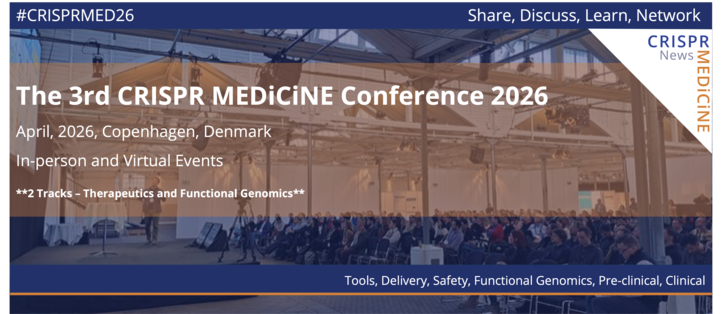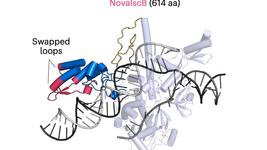CMN Weekly (14 April 2023) - Your Weekly CRISPR Medicine News
By: Gorm Palmgren - Apr. 14, 2023
Top picks
- DISCOVER-Seq+ is a new method to improve in vivo CRISPR off-target detection sensitivity. Compared with previous methods, the technique can discover up to fivefold more CRISPR off-target sites in immortalised cell lines, primary human cells and mice. DISCOVER-Seq+ works by inhibition of DNA-dependent protein kinase catalytic subunit. This leads to the accumulation of the repair protein MRE11 at CRISPR-Cas-targeted sites, enabling high-sensitivity mapping of off-target sites to positions of MRE11 binding using chromatin immunoprecipitation followed by sequencing. You can read more about DISCOVER-Seq+ in this News & Views article.
- The association of toxin-antitoxin with CRISPR-Cas is reported as an efficient antimicrobial strategy to kill multidrug-resistant (MDR) pathogens. The method programmes CRISPR-Cas to target antibiotic resistance gene(s) to kill MDR pathogens or cure their resistance selectively. Cell death is triggered as the last resort when CRISPR-Cas is inactivated or suppressed by unwanted genetic or non-genetic events/factors.
Research
- American researchers report high-efficiency and multilocus targeted integration in CHO cells using CRISPR-mediated donor nicking and DNA repair inhibitors. The method enabled the integration of transgene expression cassettes with 96% efficiency at a single locus and 53%–55% efficiency at two loci simultaneously in selected clones.
- Researchers in the USA have used CRISPR-Cas9 to prevent ventricular arrhythmias associated with cardiomyocyte cell therapy. In human pluripotent stem cell-derived cardiomyocytes, the team used gene editing to abolish depolarisation-associated genes and overexpress a hyperpolarisation-associated gene. As a result, these cells lack automaticity but contract when externally stimulated.
- American researchers have used CRISPR-Cas9 to generate human hypoimmune (HIP) T cells by disrupting three genes and subsequently used lentiviral transduction to make the cells express CD47 and anti-CD19 CAR. These hypoimmune anti-CD19 chimeric antigen receptor T cells provided lasting tumour control in fully immunocompetent allogeneic humanised mice.
- Researchers in Japan have optimised Cas9 activity by adding cytosine extensions to single-guide RNAs. Extensions of various lengths reduced cytotoxicity in human pluripotent stem cells, enhanced homology-directed repair while maintaining bi-allelic editing, and improved the specificity and precision of mono-allelic editing.
Industry
- An influential US drug pricing group has calculated that exa-cel, Vertex and CRISPR Therapeutics's one-dose gene editing therapy for sickle cell disease, would be cost-effective if priced at up to $1.9 million. A Nature Reviews Drug Discovery news feature summarises how exa-cel has entered the regulatory spotlight.
- A new startup, Function Oncology, has secured $28 million in financing to support the development of a CRISPR-based technology that identifies targets for a patient's cancer regardless of whether or not they are mutated. Function Oncology plans to bring its technology to the market as a laboratory-developed test, a pathway that does not require FDA review.
Detection
- A new method uses a CRISPR-Cas12a biosensor array for ultrasensitive detection of unamplified DNA with single-nucleotide polymorphic discrimination. The technique utilises a CRISPR-Cas12a-mediated graphene field-effect transistor (gFET) array and can discriminate single-nucleotide polymorphisms.
- Researchers in China have developed a light-start CRISPR‒Cas12a reaction by employing caged CRISPR RNA (crRNA). The photocontrolled one-pot assay is simpler and is 50-fold more sensitive than the conventional assay for nucleic acid detection.
- A new CRISPR-based quantum dot nanobead lateral flow assay can detect varicella-zoster virus (VZV) in less than one hour. In 86 clinical vesicle samples, the test shows 100% concordance with quantitative real-time PCR for VZV detection.
- Chinese researchers have reviewed the recent progress in aptamer and CRISPR-Cas12a-based systems for non-nucleic target detection. The review summarises the working principle and recent progress in CRISPR-Cas12a/Apt technology in applying non-nucleic acid target detection.
Reviews
- Prime editing: advances and therapeutic applications. This review summarises the latest developments in optimising prime editor (PE) variants with improved editing efficiency and precision. Moreover, it highlights some potential therapeutic applications.
- In the business of base editors: Evolution from bench to bedside. This review provides an overview of the mechanics of base editing and its use in clinical trials. In addition, the piece elaborates on the recent developments around Vertex and CRISPR Therapeutics' first-in-modality genome-editor exa-cel for the treatment of two haemoglobinopathies that has entered the regulatory spotlight.
- The design and application of DNA-editing enzymes as base editors. This review showcases DNA-editing enzymes repurposed, redesigned, and developed into programmable base editors. These include deaminases, glycosylases, methyltransferases, and demethylases.
- CRISPR-based biosensing strategies: Technical development and application prospects. This review elaborates on the core biochemical properties underpinning the development of CRISPR bioassays, the technical developments, and the obstacles to the commercial application of CRISPR detection technology and explores development opportunities and directions.
- A review of CRISPR-based advances in dermatological diseases. This review introduces the adoption of CRISPR technology to study different skin disorders, including monogenic genodermatoses, inflammatory conditions, and cutaneous infections. It highlights the promising preclinical results of CRISPR-mediated treatment and important mechanic discoveries in investigative studies.
- Nanotechnology-enabled gene delivery for cancer and other genetic diseases. This review outlines the multiple biological barriers associated with gene-delivery processes. In addition, it highlights recent advances in gene therapy strategy in vivo, including gene correction, gene silencing, gene activation and genome editing.
- Gene therapy for paediatric homozygous familial hypercholesterolaemia. The review discusses this issue in the paediatric patient group with severe compound heterozygous or homozygous null variants associated with aggressive early-onset atherosclerosis and myocardial infarction, along with the critical preclinical studies that use genomic editing strategies to treat HoFH in place of apheresis and liver transplantation.
- Gene therapy for Urea Cycle Defects: an update from historical perspectives to prospects. This review presents the historical path and state-of-the-art gene therapy technologies for urea cycle defects. Moreover, it discusses the current advantages and pitfalls driving future directions for research and development.
- Recent advances in therapeutic CRISPR-Cas9 genome editing: mechanisms and applications. This review focuses on the evolution and mechanisms of CRISPR-Cas9-derived editing tools and their applications in gene therapy.
News from CRISPR Medicine News
- Last Wednesday, just before Easter, we brought the latest CRISPR clinical trial updates from Caribou Biosciences. The company's second gene-edited CAR-T cell therapy candidate, CB-011, has entered the clinic for multiple myeloma. At the same time, dose expansion is set to commence for its frontrunner candidate CB-010, which is being developed to treat non-Hodgkin lymphoma.
To get more of the CRISPR Medicine News delivered to your inbox, sign up to the free weekly CMN Newsletter here.
Tags
CLINICAL TRIALS
Castration-Resistant Prostate Cancer, CRPC, and Salivary Gland Cancer, SGC, (NCT04249947)
Sponsors:
Poseida Therapeutics, Inc.
Sponsors:
Poseida Therapeutics, Inc.
IND Enabling
Phase I
Phase II
Phase III
IND Enabling
Phase I
Phase II
Phase III
IND Enabling
Phase I
Phase II
Phase III







